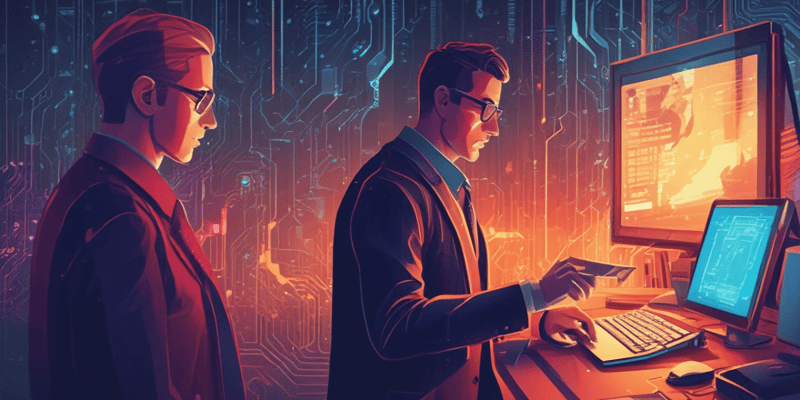Podcast
Questions and Answers
What is the primary goal of security controls?
What is the primary goal of security controls?
Which of the following best describes technical controls?
Which of the following best describes technical controls?
What type of security control involves mechanisms like security cameras and door locks?
What type of security control involves mechanisms like security cameras and door locks?
Which of the following categories of security controls includes risk assessments and guidelines?
Which of the following categories of security controls includes risk assessments and guidelines?
Signup and view all the answers
What is the function of preventive controls?
What is the function of preventive controls?
Signup and view all the answers
Operational controls are categorized primarily by which of the following characteristics?
Operational controls are categorized primarily by which of the following characteristics?
Signup and view all the answers
Which security control type includes activities like awareness training and backup procedures?
Which security control type includes activities like awareness training and backup procedures?
Signup and view all the answers
What aspect of security do managerial controls primarily address?
What aspect of security do managerial controls primarily address?
Signup and view all the answers
What is the primary objective of deterrent controls?
What is the primary objective of deterrent controls?
Signup and view all the answers
Which of the following examples most closely represents a corrective control?
Which of the following examples most closely represents a corrective control?
Signup and view all the answers
Compensating controls are typically implemented when which of the following occurs?
Compensating controls are typically implemented when which of the following occurs?
Signup and view all the answers
What category do guidelines and procedures associated with directing behavior fall under?
What category do guidelines and procedures associated with directing behavior fall under?
Signup and view all the answers
In which scenario would IDS be categorized as a primary control?
In which scenario would IDS be categorized as a primary control?
Signup and view all the answers
Which of the following best describes detective controls?
Which of the following best describes detective controls?
Signup and view all the answers
An organization implementing CAPTCHA systems is likely using compensating controls for which reason?
An organization implementing CAPTCHA systems is likely using compensating controls for which reason?
Signup and view all the answers
What type of control would a visible security presence at a company primarily be considered?
What type of control would a visible security presence at a company primarily be considered?
Signup and view all the answers
Study Notes
Security Controls - GuidesDigest Training
- Security controls are mechanisms, policies, or procedures to protect assets and data, reducing threats.
- Understanding control types is key for implementing secure systems and passing security exams.
- The "Prevent, Detect, React" model is crucial for categorizing security controls.
Categories of Security Controls
- Technical Controls (Logical Controls): Implemented through technology (e.g., firewalls, intrusion detection systems, encryption). Often require software/hardware to enforce policies.
- Managerial Controls: Focus on governance and administration. Include policies, procedures, guidelines, risk assessments, data classification, and security training. They direct operational and technical controls.
- Operational Controls: Mechanisms acting upon managerial guidance. Technology-driven, often with human input (e.g., backup procedures, incident response, training).
- Physical Controls: Tangible security aspects (e.g., security cameras, biometric scanners, door locks, visitor logs). These protect physical access to information and systems.
Types of Security Controls
- Preventive Controls: Stop events or actions (e.g., firewalls, access control lists, strong authentication).
- Deterrent Controls: Discourage attackers (e.g., warning signs, security personnel).
- Detective Controls: Discover unwanted activities (e.g., system monitoring, intrusion detection systems).
- Corrective Controls: Fix security incidents (e.g., patch management, system restoration).
- Compensating Controls: Used when primary controls are not feasible. These provide similar protection in a temporary way.
- Directive Controls: Direct people, often through guidelines or policies (e.g., password change policies).
Key Points
- Security controls ensure integrity, availability, and confidentiality of information systems.
- Security controls are categorized as technical, managerial, operational, and physical.
- They can be further classified as preventive, deterrent, detective, corrective, compensating, and directive.
Review Questions
- What are the four main categories of security controls?
- Give examples of preventive and detective controls.
- What is the primary function of directive controls?
- How do compensating controls differ from corrective controls?
Practical Exercises
- Map security controls in your organization or a hypothetical one, categorizing each control.
- Create flashcards or tables to memorize control types and categories using real-world examples for a comprehensive understanding.
Studying That Suits You
Use AI to generate personalized quizzes and flashcards to suit your learning preferences.
Related Documents
Description
This quiz provides an overview of security controls essential for protecting assets and data. It discusses various types of controls including technical, managerial, operational, and physical. Understanding these categories is vital for implementing secure systems and succeeding in security assessments.





